Cao Liu
Learning or Self-aligning? Rethinking Instruction Fine-tuning
Mar 02, 2024



Abstract:Instruction Fine-tuning~(IFT) is a critical phase in building large language models~(LLMs). Previous works mainly focus on the IFT's role in the transfer of behavioral norms and the learning of additional world knowledge. However, the understanding of the underlying mechanisms of IFT remains significantly limited. In this paper, we design a knowledge intervention framework to decouple the potential underlying factors of IFT, thereby enabling individual analysis of different factors. Surprisingly, our experiments reveal that attempting to learn additional world knowledge through IFT often struggles to yield positive impacts and can even lead to markedly negative effects. Further, we discover that maintaining internal knowledge consistency before and after IFT is a critical factor for achieving successful IFT. Our findings reveal the underlying mechanisms of IFT and provide robust support for some very recent and potential future works.
Generative Calibration for In-context Learning
Oct 16, 2023



Abstract:As one of the most exciting features of large language models (LLMs), in-context learning is a mixed blessing. While it allows users to fast-prototype a task solver with only a few training examples, the performance is generally sensitive to various configurations of the prompt such as the choice or order of the training examples. In this paper, we for the first time theoretically and empirically identify that such a paradox is mainly due to the label shift of the in-context model to the data distribution, in which LLMs shift the label marginal $p(y)$ while having a good label conditional $p(x|y)$. With this understanding, we can simply calibrate the in-context predictive distribution by adjusting the label marginal, which is estimated via Monte-Carlo sampling over the in-context model, i.e., generation of LLMs. We call our approach as generative calibration. We conduct exhaustive experiments with 12 text classification tasks and 12 LLMs scaling from 774M to 33B, generally find that the proposed method greatly and consistently outperforms the ICL as well as state-of-the-art calibration methods, by up to 27% absolute in macro-F1. Meanwhile, the proposed method is also stable under different prompt configurations.
Interpreting Sentiment Composition with Latent Semantic Tree
Aug 31, 2023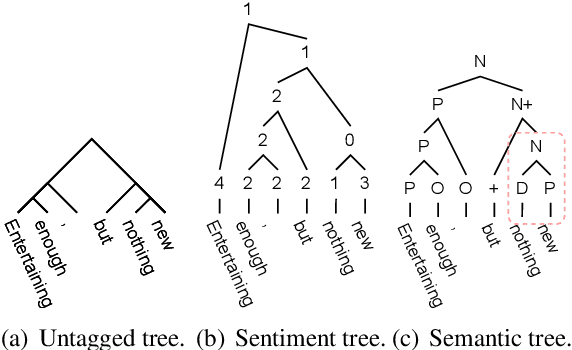
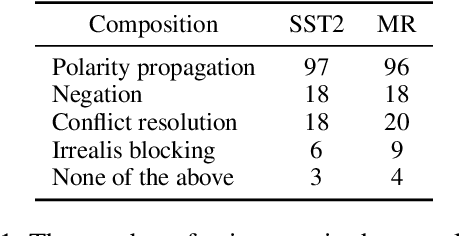
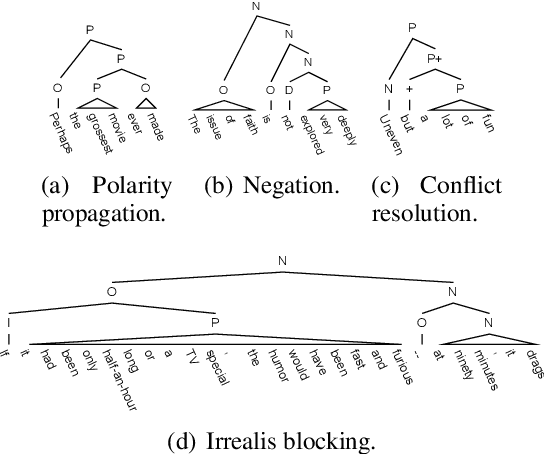

Abstract:As the key to sentiment analysis, sentiment composition considers the classification of a constituent via classifications of its contained sub-constituents and rules operated on them. Such compositionality has been widely studied previously in the form of hierarchical trees including untagged and sentiment ones, which are intrinsically suboptimal in our view. To address this, we propose semantic tree, a new tree form capable of interpreting the sentiment composition in a principled way. Semantic tree is a derivation of a context-free grammar (CFG) describing the specific composition rules on difference semantic roles, which is designed carefully following previous linguistic conclusions. However, semantic tree is a latent variable since there is no its annotation in regular datasets. Thus, in our method, it is marginalized out via inside algorithm and learned to optimize the classification performance. Quantitative and qualitative results demonstrate that our method not only achieves better or competitive results compared to baselines in the setting of regular and domain adaptation classification, and also generates plausible tree explanations.
MME-CRS: Multi-Metric Evaluation Based on Correlation Re-Scaling for Evaluating Open-Domain Dialogue
Jun 19, 2022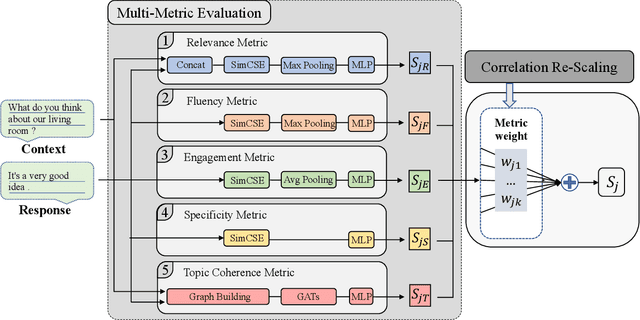
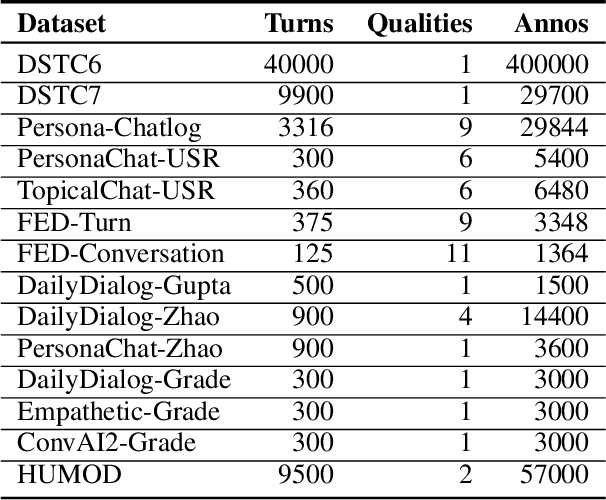
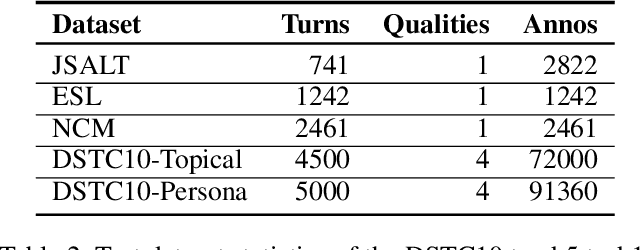

Abstract:Automatic open-domain dialogue evaluation is a crucial component of dialogue systems. Recently, learning-based evaluation metrics have achieved state-of-the-art performance in open-domain dialogue evaluation. However, these metrics, which only focus on a few qualities, are hard to evaluate dialogue comprehensively. Furthermore, these metrics lack an effective score composition approach for diverse evaluation qualities. To address the above problems, we propose a Multi-Metric Evaluation based on Correlation Re-Scaling (MME-CRS) for evaluating open-domain dialogue. Firstly, we build an evaluation metric composed of 5 groups of parallel sub-metrics called Multi-Metric Evaluation (MME) to evaluate the quality of dialogue comprehensively. Furthermore, we propose a novel score composition method called Correlation Re-Scaling (CRS) to model the relationship between sub-metrics and diverse qualities. Our approach MME-CRS ranks first on the final test data of DSTC10 track5 subtask1 Automatic Open-domain Dialogue Evaluation Challenge with a large margin, which proved the effectiveness of our proposed approach.
Confidence Calibration for Intent Detection via Hyperspherical Space and Rebalanced Accuracy-Uncertainty Loss
Mar 17, 2022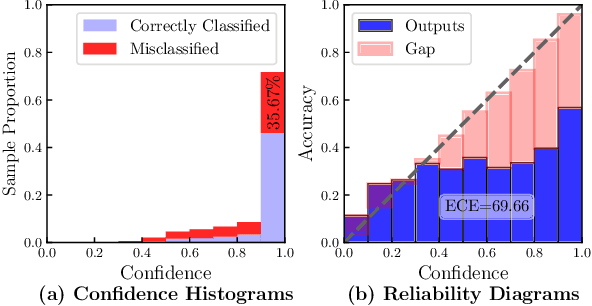

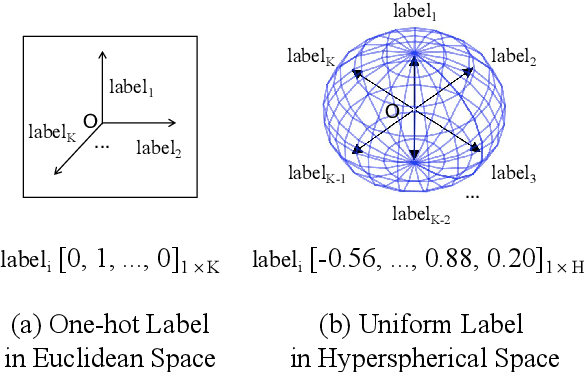
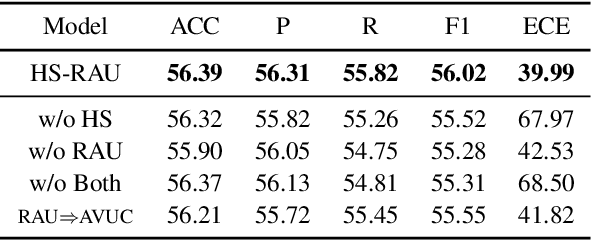
Abstract:Data-driven methods have achieved notable performance on intent detection, which is a task to comprehend user queries. Nonetheless, they are controversial for over-confident predictions. In some scenarios, users do not only care about the accuracy but also the confidence of model. Unfortunately, mainstream neural networks are poorly calibrated, with a large gap between accuracy and confidence. To handle this problem defined as confidence calibration, we propose a model using the hyperspherical space and rebalanced accuracy-uncertainty loss. Specifically, we project the label vector onto hyperspherical space uniformly to generate a dense label representation matrix, which mitigates over-confident predictions due to overfitting sparce one-hot label matrix. Besides, we rebalance samples of different accuracy and uncertainty to better guide model training. Experiments on the open datasets verify that our model outperforms the existing calibration methods and achieves a significant improvement on the calibration metric.
Density-Based Dynamic Curriculum Learning for Intent Detection
Aug 24, 2021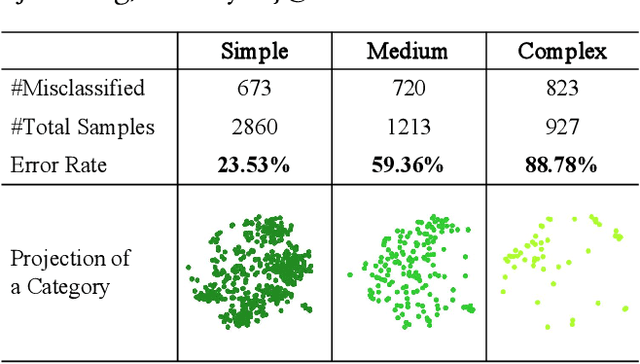

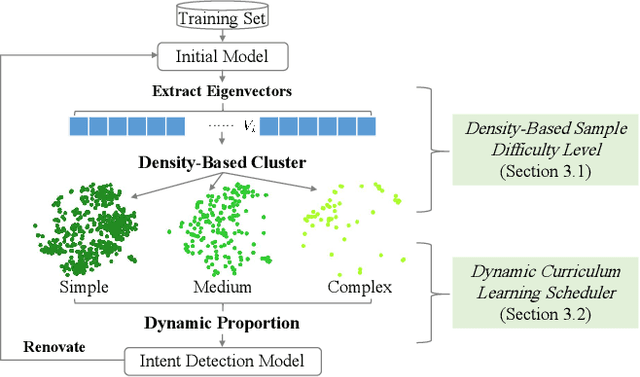
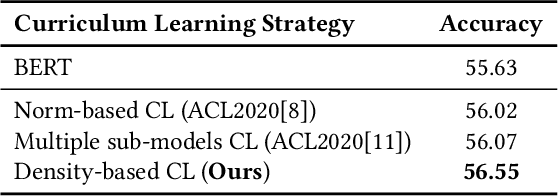
Abstract:Pre-trained language models have achieved noticeable performance on the intent detection task. However, due to assigning an identical weight to each sample, they suffer from the overfitting of simple samples and the failure to learn complex samples well. To handle this problem, we propose a density-based dynamic curriculum learning model. Our model defines the sample's difficulty level according to their eigenvectors' density. In this way, we exploit the overall distribution of all samples' eigenvectors simultaneously. Then we apply a dynamic curriculum learning strategy, which pays distinct attention to samples of various difficulty levels and alters the proportion of samples during the training process. Through the above operation, simple samples are well-trained, and complex samples are enhanced. Experiments on three open datasets verify that the proposed density-based algorithm can distinguish simple and complex samples significantly. Besides, our model obtains obvious improvement over the strong baselines.
Generating Questions for Knowledge Bases via Incorporating Diversified Contexts and Answer-Aware Loss
Oct 29, 2019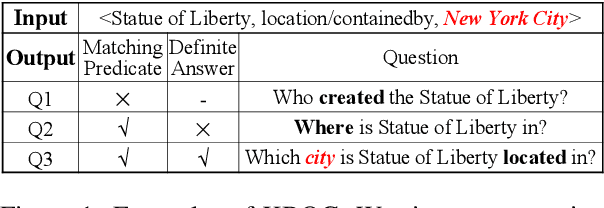

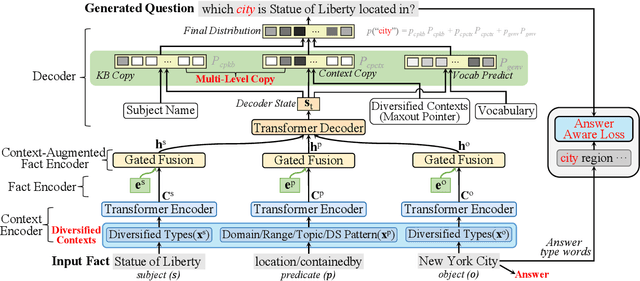

Abstract:We tackle the task of question generation over knowledge bases. Conventional methods for this task neglect two crucial research issues: 1) the given predicate needs to be expressed; 2) the answer to the generated question needs to be definitive. In this paper, we strive toward the above two issues via incorporating diversified contexts and answer-aware loss. Specifically, we propose a neural encoder-decoder model with multi-level copy mechanisms to generate such questions. Furthermore, the answer aware loss is introduced to make generated questions corresponding to more definitive answers. Experiments demonstrate that our model achieves state-of-the-art performance. Meanwhile, such generated question can express the given predicate and correspond to a definitive answer.
Incorporating Interlocutor-Aware Context into Response Generation on Multi-Party Chatbots
Oct 29, 2019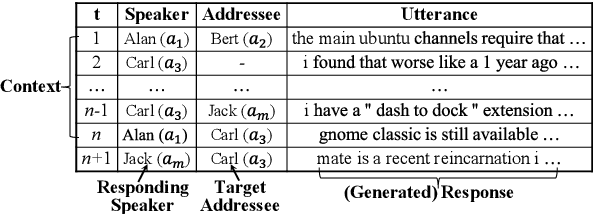
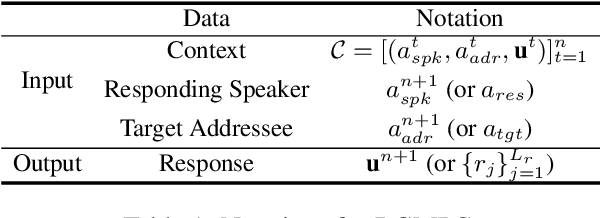
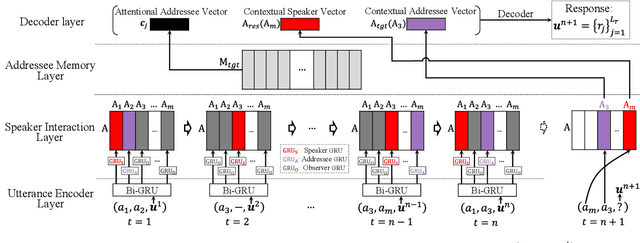
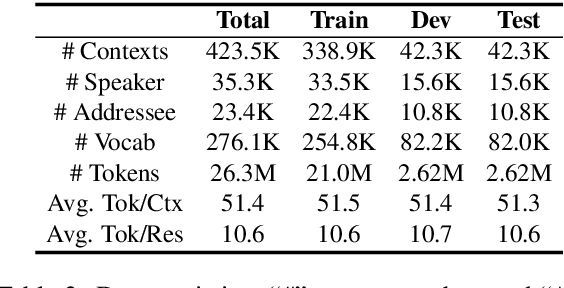
Abstract:Conventional chatbots focus on two-party response generation, which simplifies the real dialogue scene. In this paper, we strive toward a novel task of Response Generation on Multi-Party Chatbot (RGMPC), where the generated responses heavily rely on the interlocutors' roles (e.g., speaker and addressee) and their utterances. Unfortunately, complex interactions among the interlocutors' roles make it challenging to precisely capture conversational contexts and interlocutors' information. Facing this challenge, we present a response generation model which incorporates Interlocutor-aware Contexts into Recurrent Encoder-Decoder frameworks (ICRED) for RGMPC. Specifically, we employ interactive representations to capture dialogue contexts for different interlocutors. Moreover, we leverage an addressee memory to enhance contextual interlocutor information for the target addressee. Finally, we construct a corpus for RGMPC based on an existing open-access dataset. Automatic and manual evaluations demonstrate that the ICRED remarkably outperforms strong baselines.
 Add to Chrome
Add to Chrome Add to Firefox
Add to Firefox Add to Edge
Add to Edge